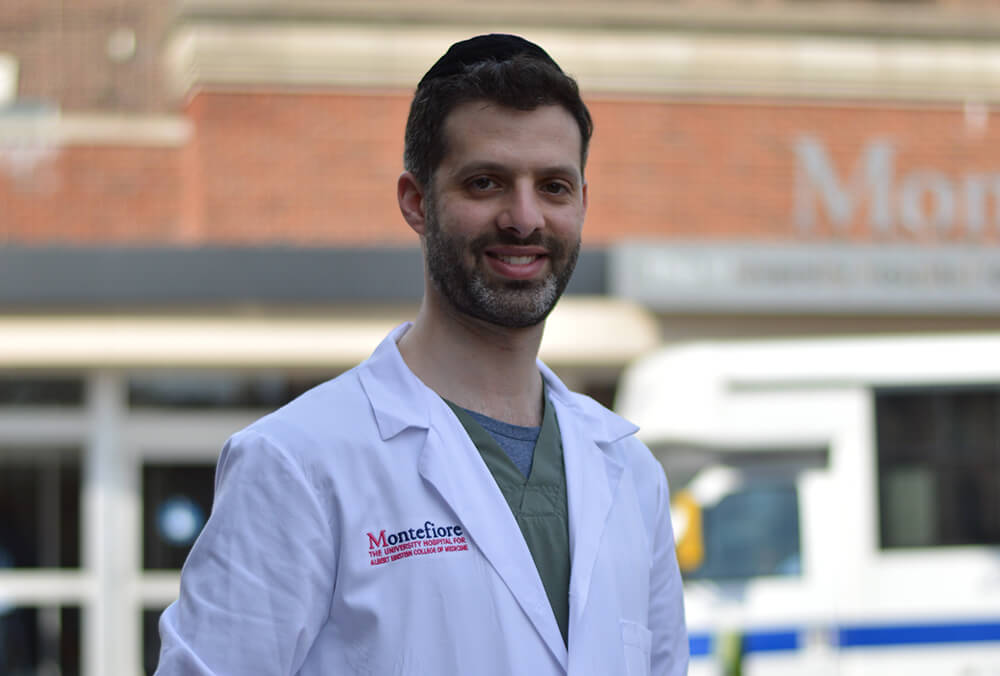An Exercise in Connection
PT Yosef Borenstein Brought the Exercise and Human Connection to Psychiatric Patients During the Pandemic

In his teens and early 20’s, Yosef Borenstein was the aquatics director at a number of summer camps, a role that foretold a passion and a career path. “One student was developmentally delayed and physically challenged,” says Borenstein, now 34. “I was working on his endurance, just coming up with exercises in the pool to help him. It was gratifying to see him gain strength and confidence, and I thought, ‘How do I take this to the next level and turn this into a career?’”
Borenstein learned that physical therapy was what he was performing intuitively with his young charge. “That was it for me,” he says. “That’s what I wanted to do.” After graduating from Touro’s Lander College of Arts and Sciences, he was accepted to The School of Health Sciences’ physical therapy program, where he graduated in 2018 with a Doctor of Physical Therapy (DPT) degree.
“What an amazing program,” says Borenstein, who is married with five children. “There isn’t a week that goes by that I’m not in touch with my former professors. They aren’t only instructors; they are working hands-on in the field today. They are educators and practitioners.”
They taught him well. Today he works as a physical therapist at Montefiore Medical Center, the University Hospital for Albert Einstein College of Medicine in the Bronx. With 800 beds, the nationally respected medical institution is comprised of over 10 hospitals and is one of the largest medical providers in New York State.
An athletic person who believes aerobic exercise in some form can help everyone physically and emotionally, Borenstein has created an in-patient fitness program for psychiatric patients at Montefiore.
Before COVID-19 vaccines were available, the physical therapists and all other hospital clinicians were only in the psychiatric ward on a limited basis, for fear of a viral spread.
“Everyone was so isolated, but especially our psychiatric patients, who already struggle with social interactions,” he says. “People think psychiatric patients are all homeless or drug addicts, and they’re mostly wrong. We treat doctors, lawyers, bankers, businessmen, a lot of severely depressed and bipolar people, who felt even more alone during the pandemic. Look, the pandemic did us all in, but for many of these patients, it was the trigger that landed them here.”
As COVID-19 numbers decreased and vaccinations became readily available for health providers, Borenstein and the other physical therapists were allowed back in the 30-bed psychiatric unit. He immediately noticed how desperate the patients were for outside contact, familiar faces, new faces.
“They were thirsty for interaction,” he says. “They would stop us and make small talk and just look happy to see a new face. I decided we had to do something to help them.”
His idea was an aerobic exercise and mobility program in a group setting. “They spend a lot of time alone and live a pretty sedentary lifestyle,” he says. “This would be a way for them to interact with other people — and get moving.”
Already, 12 therapists from multiple areas of focus — occupational, speech, rehab and more — as well as doctors, are participating in the once-a-week program. One is in charge of the playlist. “Upbeat and contemporary music only,” Borenstein urged, “for those patients who can and want to join in.” The professionals all have given up their lunch hours to be part of this multidisciplinary effort.
Borenstein says the once-a-week class is not nearly enough. He is now writing grants to turn the exercise and mobility program into a larger research project that will show through data what he already knows: “Exercise is both free and priceless.”

